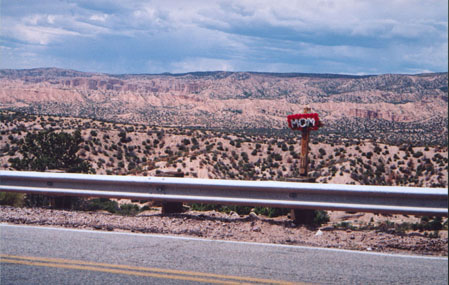 |
Making Space on the Side of the Road: Towards A Cultural Study of Roadside Car Crash Memorials
With Words and Pictures by Bob Bednar |
 |
Making Space on the Side of the Road: Towards A Cultural Study of Roadside Car Crash Memorials
With Words and Pictures by Bob Bednar |
This fear of death, or the fear of some other kind of erasure, fuels the desire for participation and for communication. Dissolution threatens, but also necessitates, communication.
Gillian Rose, "Performing Inoperative Community" (1997)
The project started out innocently enough. It was late January. It was late at night. Time to make a final decision on a proposal for a panel and paper at the American Studies Association conference. Violence and Belonging. I'd been talking to Renee about a panel since we saw each other again in Houston at ASA in November. The panel idea--visuality and violence--sounded good: just enough glue to hold it together but lots of angles and lots of room for each of us to move.
With a sixteen month-old daughter, Anika, in the house, late at night is the only time my wife, Danielle, and I can work together in the same time and place at home. We were both in the back room, surrounded by piles of papers, books, and toys. It's a microcosm.
I was talking with Danielle some more, hoping that it would help me see an angle. As we talk, it hit me quickly, fiercely: roadside car crash memorials.
I had seen them all over town and everywhere I travel but had never thought too much about them. I buzz with excitement as I realize that roadside car crash memorials are structured by and circulate within some of the same discourses as my other work on tourism snapshots in public landscapes (hybrid vernacular spatial practices, cultural signifying practices that are both/and, neither/nor public/private, etc.). Just as tourist snapshots transform a public landscape into a personal landscape, I think, roadside memorials transform a social space--a roadside right of way used and owned by the public but policed by public institutions--into a place for private memorials displayed in public. It seems like a great next step for me.
I think about September 11th, about Oklahoma City, Columbine, JFK, Jr., Princess Diana, the Vietnam War Veterans Memorial in DC. I think about how some deathsites like Oklahoma City are marked with a public monument to officially make the private tragedies part of public culture, public history, and other deathsites are not officially marked at all. When does a private history become public? When does it not? Who gets screen time and who does not? Who gets screen time and voice over? Who does the culture remember, and who does it not? Who does it not recognize, or even perceive?
In February, my copy of Holly Everett's Roadside Crosses in Contemporary Memorial Culture arrives from amazon. I had been gathering newspaper articles and TxDOT depositions, scanning websites, photographing some of the many roadside memorials in and around Austin, Texas, and interviewing local people who build and maintain roadside memorials. My work was feeling productive, engaging.
To my surprise and dismay, Everett's book is a case study of roadside crosses in--of all places--Austin, Texas. I decide that if I want something new to say, I'm going to need something new to see. Based on my previous travels, I knew that there were some very elaborate and visible memorial sites along the roads between Santa Fe and Taos, and I had already been planning to travel there as the project unfolded. Now it looks more urgent. Besides, all the accounts of roadside memorials I am reading have traced the practice back hundreds of years in the Hispanic Southwest, where the memorials are called descansos (or "resting places"). Rooted in the traditional practice of marking the resting places of funeral processions winding their way on foot through the Sangre de Cristo Mountains, the practice was adapted to roadside car crash memorials in the twentieth century to mark what Rudolfo Anaya calls the "interrupted journey."
I spend the rest of the spring and the beginning of summer feverishly reading new research and theory in feminist cultural geography, ethnography and anthropology, folklore, visual culture, and material culture. Worlds within worlds, I'm finding.
All Design, Photography, and Text © 2004
by Bob Bednar
Department of Communication Studies
Southwestern University
Georgetown, Texas 78626
(512) 863-1440
bednarb@southwestern.edu